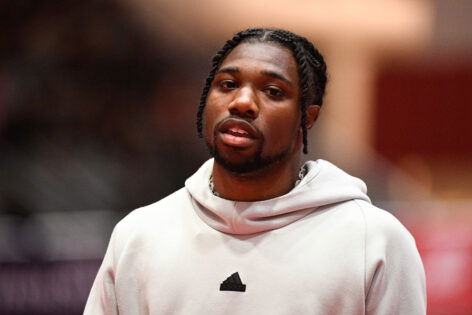The inaugural Grand Slam Track meet in Kingston, Jamaica, didn’t go as planned. Close your eyes and imagine the legends like Gabby Thomas, Sydney McLaughlin-Levrone, and Vernon Norwood showing their mettle in what was promised to be one of the most exciting events in track, in front of… Well, not a lot of people. The lack of spectators at Kingston put a huge question mark over the event’s appeal, and it did not take long for the likes of Noah Lyles and Rai Benjamin to come out with their arguments on why the event didn’t work out the way it had been promised to. Yet, Michael Johnson was confident that things would work out. “Obviously, look, let’s be honest. We would love to see more spectators here, you know?” Johnson said after the first GST event. “We think we’ll get that. We think that’ll happen. But the crowd was engaged, and that’s what’s really important. People were really engaged with what’s happening here.”
And make no mistake, the Miami leg, spanning over May 2-5, was an excellent chance for the event to wipe out the low-attendance curse. And for a moment, visuals of the packed Ansin Sports Complex did make it seem like Johnson’s optimism wasn’t misguided. But the math said a different story. That’s because the stadium in Miramar, Florida, can only accommodate a little over 5,000 spectators. So even if it was packed to the brim, it still couldn’t hold a candle to the 8,000 people who turned up to see the first leg at the 35,000-capacity National Stadium in Kingston. So if a change in locations wasn’t the solution, could it be that Johnson’s Grand Slam Track is simply not interesting enough? Well, that’s not what Justin Gatlin thinks.
Noah Lyles and others put the broadcasting flaws on notice for an underwhelming output
From excessive downtime to the same repetitive filler content, the GST’s TV coverage didn’t really sit well with the fans. Of course, you can’t expect the world out of a newly-born event, but taking notes from the naysayers might open the avenue for a future breakout.
Did you feel sick of the petty fluff pieces and commentary instead of the spicy action between races? Well, you’re not alone. Noah Lyles, Grant Holloway, Rai Benjamin, and others backed you up with a pointed complaint.
The legendary trio zeroed in on GST’s slow and uninspired way of broadcasting. In an episode of The Beyond The Records podcast in April Noah Lyles explained, “So what usually happens is they would run a race. The pre-show start was 40 minutes from start time to the first gun… then they talk about the time. And then they go to commercial, and when they come back. You’re kind of just watching random video footage of anything that’s going on. Maybe a child in the audience for about 15 to 10 more minutes.”
He didn’t speak out of the blue. The less engaging elements and the stockish approach of presenting the 10-15 minutes pep talk before the next star crops up can really test the patience of the fans. They will lose interest, and you know the aftermath of their feelings in the upcoming ticket counts. Olympic gold medalist Grant Holloway also doubled down. “Let’s not have this whole little talk show for about 10-15 minutes until the next event starts. Because at some point I’m over here doing practice swings with my putter and my irons, and I forget the track meet is on.” But as Lyles and Holloway pointed out, what went south for the broadcast, Rai Benjamin went a bit further and suggested a solution. “What they should do between events is provide a detailed breakdown—show what runners did right and what they did wrong in the previous race… It would make the overall broadcast more educational and engaging,” explained Benjamin. That might just work. After all, it’s a formula that most sports broadcasts follow. And if it has worked for them, maybe there’s a chance it’ll work for GST as well. We’ll see.
The post Justin Gatlin Jumps to Grand Slam Track’s Defense Following Harsh Criticism from Noah Lyles and Rai Benjamin appeared first on EssentiallySports.
